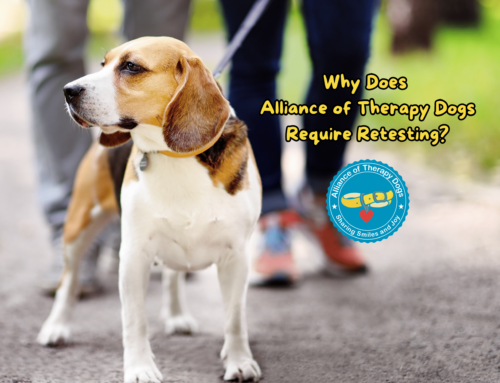Dogs have earned the title of man’s best friend for a number of reasons over the centuries. Their pleasing and loving nature, predisposition to cuddling, and intense sense of loyalty make them the kind of companion that stays by your side through thick and thin. Another unique attribute of dogs is that they show a natural inclination toward helping people. For many years, humans have been using dogs to assist in therapeutic settings because of their inherent ability to cheer up humans. Scientifically speaking, dogs have been proven to show empathy and sympathy for their human counterparts. These characteristics reveal themselves especially when someone is in emotional distress. Dogs nuzzle or whine at a person who is displaying signs of sadness. It is this sensitivity to the human emotional state of being that makes a dog such an effective therapy dog. Next are a couple of reasons why therapy dogs are a very big value to a person with disabilities.
What are the Duties of a Therapy Dog?
The duties of a therapy dog require them to have a friendly and patient temperament, much like a good therapist. Therapy dogs come in all shapes, sizes, and breeds, but they all share a common purpose. Therapy teams (dog and handler) provide comfort and companionship to those with disabilities and mental illnesses.
Interacting with a therapy dog can lessen the enormous emotional weight that people experience, especially those with disabilities and others during emotional upset. A dog cannot cure all, but he or she can certainly help lighten and lift the mindset of a patient to the point of recovery and even personal growth.
Therapy dogs are brought into certain venues and places of healing in order to interact with those under stress. Some places where their services are especially helpful include:
- Hospitals
- Retirement homes
- Schools
- Nursing homes
- Rehabilitation centers
- Disaster sites
- Airports
These types of locations all involve people who need the empathy a dog can offer–no judgment, only love, and licks. At schools, those with learning disabilities become less anxious and more confident with a therapy dog as their companion. Children are comforted when reading to a therapy dog because the dog does not judge their ability to read. In nursing homes, a therapy dog can cheer and encourage the elderly. In disaster situations, therapy dogs provide those who are suffering from trauma with a comforting and cuddly friend to help them emotionally recover from the crisis.
Overall, a therapy dog’s temperament is essential to the success of their duties. They must be okay with people touching, petting, hugging, and handling them in potentially clumsy or accidentally harsh ways. The dog must not become distressed with physical contact. This is why it is so important for a therapy dog to have a calm temperament. Without it, there is a potential risk that the dog may become defensive and nip or bite a patient, which would be counterproductive to the goals of dog therapy.
What are Some Activities with Therapy Dogs?
Once a therapy dog reaches a venue, patients are encouraged to pet and even play with the dog. Some patients may feel more comfortable simply looking at the dog. Smaller dogs are the perfect size to sit on someone’s lap. These activities provide entertainment and a sense of companionship to someone in need of a friend and a moment of mental respite.
The Value of Therapy Dogs
The presence of a therapy dog helps someone who is struggling take their mind off of their problems and anxieties for a while. The companionship of a therapy dog facilitates real chemical changes in the body of the patient. It has been proven that most patients with therapy dog experiences have lower stress levels, increased calmness and happiness, and are less likely to feel lonely or forgotten. This is reason enough to support the action of making your dog into a therapy dog today.
If you are interested in having your dog become a therapy dog, the Alliance of Therapy Dogs can help you understand how to get your dog certified, registered, and insured. Together, you and your dog can help change the lives of those who might need a furry friend. For some people without family or friends to visit, the time spent with a therapy dog could be the difference between a speedy recovery or continued suffering. Therapy dogs are like the live version of holding a fluffy pillow when you’re sad–their empathy alleviates sadness in a way that is difficult to mirror in any other therapeutic method.






